Water conservation
Residential water saving tips
One of the best ways to avoid wasting water is to read your water meter regularly. Not only will you avoid estimated readings, but regular meter readings will help you detect water leaks in your home.
Here is a great way to detect a leak. Pick a time when you and your family will be out of your home for a few hours. Before you leave home, take a water meter reading. When you arrive back home, before anyone uses any water, take another meter reading. If the meter reading has changed, you have a leak and further investigation is required.
Saving water in the kitchen and laundry
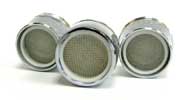 Install a low flow kitchen faucet aerator. This can reduce the flow out of your tap by up to 40 per cent. These easy to install devices are available from your local plumbing retailer.
Install a low flow kitchen faucet aerator. This can reduce the flow out of your tap by up to 40 per cent. These easy to install devices are available from your local plumbing retailer.- Use your automatic dishwasher only for full loads.
- If you wash dishes by hand, don't leave the water running for rinsing. If you have two sinks, fill one with soapy water and one with rinse water. If you have only one sink, gather washed dishes in a dish rack and rinse them with a spray device or a panful of hot water.
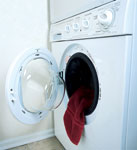 Be water wise when boiling vegetables. Use only enough water to cover them, and use a tight-fitting lid. Steaming vegetables uses even less water, while conserving more nutrients.
Be water wise when boiling vegetables. Use only enough water to cover them, and use a tight-fitting lid. Steaming vegetables uses even less water, while conserving more nutrients.- Don't let the kitchen faucet run while you clean vegetables. Rinse them in a sink with the drain plug in or a pan of clean water.
- Keep a bottle of drinking water in the refrigerator. Running tap water to cool it off for drinking water is wasteful.
- Check faucets and pipes for leaks. Leaks waste water 24 hours a day, 7 days a week, and can often be repaired with an inexpensive washer.
- As appliances and fixtures wear out, replace them with ENERGY STAR certified and WaterSense labelled products .
Saving water in the bathroom
 Replace your old water-guzzling toilet with a WaterSense labelled model. New toilets use only 4.8 litres per flush while older toilets can use over 20 litres per flush. Calculate the payback period for purchasing a new WaterSense labelled toilet.
Replace your old water-guzzling toilet with a WaterSense labelled model. New toilets use only 4.8 litres per flush while older toilets can use over 20 litres per flush. Calculate the payback period for purchasing a new WaterSense labelled toilet.- Check your toilets for leaks. Put a little food color or a dye tablet in your toilet tank. If, without flushing, the color begins to appear in your bowl, you have a leak that should be repaired immediately.
- Install toilet water saving devices. If you would like to retrofit your old toilet, early closure toilet flappers or toilet dams are available from your local plumbing retailer. These devices can save 4 to 8 litres of water with every flush.
- Don't use the toilet as an ashtray or wastebasket. Every time you flush a cigarette butt, facial tissue or other small bit of trash, you waste 6 to 20 litres of water.
- Install WaterSense labelled showerheads. This can reduce the flow up to 40 percent. These easy to install devices are available from your local plumbing retailer.
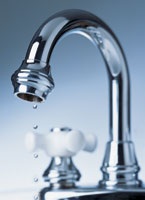 Take shorter showers, 5 minutes maximum. Limit your showers to the time it takes to soap up, wash down and rinse off. Long, hot showers can waste 18 to 35 litres of water.
Take shorter showers, 5 minutes maximum. Limit your showers to the time it takes to soap up, wash down and rinse off. Long, hot showers can waste 18 to 35 litres of water.- Take baths. A bath in a partially filled tub uses less water than all but the shortest showers.
- Install low flow bathroom faucet aerators. This can reduce the flow out of your tap by up to 40 percent. These easy to install devices are available from your local plumbing retailer.
- Turn off the water after you wet your toothbrush. There is no need to keep water pouring down the drain - just wet your brush and fill a glass for mouth rinsing.
- Rinse your razor in the sink. Fill the bottom of the sink with a few centimetres of warm water. This will rinse your blade just as well as running water, and far less wastefully.
- Check faucets and pipes for leaks. Even the smallest drip from a worn washer can waste 75 or more litres of water a day. Larger leaks can waste hundreds of litres of water before the problem is found and repaired.
Saving water outside
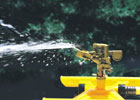 Water your lawn only when it needs it. A good way to see if your lawn needs watering is to step on the grass. If it springs back when you move, it doesn't need water. If it stays flat, fetch the sprinkler.
Water your lawn only when it needs it. A good way to see if your lawn needs watering is to step on the grass. If it springs back when you move, it doesn't need water. If it stays flat, fetch the sprinkler.- Water during the cool parts of the day. Early morning generally is better than dusk since it helps prevent the growth of fungus.
- Deep-soak your lawn. When you do water, do it long enough for the moisture to soak down to the roots where it will do the most good. A light sprinkling can evaporate quickly and tends to encourage shallow root systems.
- Don't water the sidewalk. Position sprinklers so water lands on the lawn or garden - not on paved areas.
- Avoid watering on windy days.
- Xeriscape (pronounced: ZEER-iss-skape) by planting drought-resistant trees and plants. Many beautiful trees and plants thrive with far less water than other species.
- Put a layer of mulch around trees and plants. Mulch will slow evaporation of moisture and also discourage weed growth.
- Remove weeds and unhealthy plants. This way, your plants will fully benefit from the water saved.
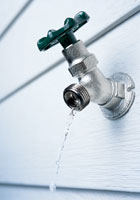 Keep your grass long. Longer grass provides shade for the roots and holds water better than shorter grass.
Keep your grass long. Longer grass provides shade for the roots and holds water better than shorter grass.- Be aware of what your plants need. In the spring and fall, most plants need about half the amount of water needed during the summer.
- Use a broom - not a hose - to clean driveways and sidewalks.
- Don't run the hose while washing your car. Clean the car with a pail of soapy water and just use the hose to rinse it off.
- Use a cover when your pool is not in use to reduce evaporation.
- Lower the pool water level to reduce the amount of water splashed out.
- Channel splashed out water from the pool onto landscaping.
- Check frequently for leaks in hoses and couplings and keep them drip-free. Leaks outside the house may not seem as bad since they're not as visible, but they are just as wasteful as leaks inside.
The ideas presented above are suggestions and not intended as an endorsement by the City of Winnipeg Water and Waste Department of any method, process or specific product.
